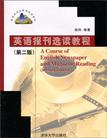英语报刊选读教程
出版时间:2010-7 出版社:清华大学出版社 作者:胡阳 页数:187
前言
我们在教学中发现,很多学生由于语言水平的局限,习惯于逐字逐句地阅读,注意力通常集中在字和句上,尤其是那些自己不认识的词上。这也就是为什么多数外语学习者总觉得词汇量太小,读不懂,不知作者(文章)所云。那么如何才能成为一个熟练的外语阅读者呢?首先要克服一些不良的阅读习惯,养成良好的阅读习惯,如: 1.用手、尺子、铅笔等指着单词,一个字一个字地读,这样无形中降低了阅读速度。要养成按照“意群”阅读的习惯,放宽眼睛“扫描”的范围,以提高阅读速度。这可以通过摘抄“好词佳句”来练习。本书每篇文章后的Useful Expressions部分就是一个示范。记忆也要从单纯的单词记忆转为短语、句子记忆。 2.必须读出声才能理解。也就是说,首先要把字符变成声音,然后由声音转化成意义,这实际上多了一个阅读程序,速度自然也就慢了下来。出声阅读是阅读的初级阶段,要成为一个熟练的阅读者,必须有意识地多进行“默读”练习,学会将字符直接转化成意义的技能。 3.只动眼睛不动手,这是许多学习者总觉得记不住文章内容的原因之一。阅读时一定要手眼并用,学会做批注,即边阅读,边把标志文章脉络的重点信息或重点词语画出来,这一方面帮助记忆,另一方面也帮助理解。 4.遇到生词就画下来,这是为什么许多英语学习者总觉得生词太多读不懂的原因之一。通常在阅读时用笔画下的应该是文章的重点,这一点我们回忆一下阅读汉语文章的过程就能发现。而遇到生词就画下来实际上对理解文章毫无帮助,而且会给阅读者本人造成一种心理压力(这么多生词肯定读不懂!),尤其在考试时就更是如此。那么试着把注意力集中到那些已经认识的词或短语上来,你会发现根据这些即使你不能理解所有的细节,也能够理解文章的基本思想。
内容概要
本书是在2003年第一版教材的基础上修订而成。新版教材在沿原有编写理念的同时在文章选材、板块设计、练习编排等方面行了修订。本书按主题分为8个单元,每单元包括1篇新闻,3篇章,所选文章渐进地增加阅读长度和难度,其后附上一定的阅理解和词汇练习,以及适量的写作练习,适合大中院校中已完英语初级阶段学习的非英语专业学习者使用,所选阅读文章均自近年来原版英文报刊杂志,题材多样。此外,为方便使用,本附有练习答案。 本书同样适合大中专院校中水平较高的英语学习者和大学英语六级、研究生入学考试及TOFEL、GRE等各类考生备考使用。
书籍目录
Unit One Economics Part A Lead-in News Reading: World Bank Sees US Recession Risk Part B Reading i Reading 1 Evaluating Good Corporate Citizenship Reading 2 "Banker" Who Lends to the Poor Wins Nobel Peace Prize Reading 3 The Cost of Survival Part C Unit AssignmentsUnit Two Environment Part A Lead-in News Reading: President Hu Jintao Commits China to Carbon-cutting Deal Part B Reading Reading 1 How Do You Junk Your Computer Reading 2 EU Governments Start Tough Climate Change Talks Reading 3 A Tree Grows in Kenya Part C Unit Assignments Unit Three Disasters Part A Lead-in News Reading: China Mourns Earthquake Victims Part B Reading Reading 1 Different Natural Disasters, Same Risky Human Habits. Reading 2 Midwest Floods Leave Red Cross in the Red Reading 3 Humans Add to Natural Disaster Risk Part C Unit AssignmentsUnit Four Science and Technology Part A Lead-in News Reading: China's First Spacewalk Succeeds Part B Reading Reading 1 Is Someone Spying on You? Reading 2 Science Lessons Should Tackle Creationism and Intelligent Design Reading 3 Spit Parties: Genetic Testing Becomes a Social Activity... Part C Unit Assignments Unit Five Education Part A Lead-in News Reading: Facebook "Cheater" Won't Be Expelled from C6llege Part B Reading Reading 1 Good Education Adds Value to Both Colleges and Society Reading 2 OLPC: Eliminating Poverty Through Education i Reading 3 "Hire" Education: A Vocational Model Succeeds Part C Unit AssignmentsUnit Six Society Part A Lead-in News Reading: Woman Causes Storm on Venice's Grand Canal Part B Reading Reading 1 Who Owns You? Reading 2 The Feelgood Factor Reading 3 Solving Asia's Food Crisis Part C Unit AssignmentsUint Seven PokiticsUint Eight SportsKey to the Exercises
章节摘录
25 increasingly vibrant pop scene. Korean singer BoA outsold all Japanese artists in March. Instead of touring Europe, Japanese women these days are just as likely to visit Seoul to have a massage and shop.[4] Meanwhile, Koreas youth, for whom the trendy present is more relevant than the remote past, sop up Japanese exports such as comic books, animated movies 30 and video games. "The Japanese did us wrong in the past," says 20-year-old Lee Ho Yun as she sips a coffee at a Seoul cacatering to Japanese manga and anita6 fans. "That doesnt mean we still have to hate Japan." During the occupation, Japan forced Koreans to take Japanese names, part of an attempt to stamp out Korean identity. Today Lee and her friends adopt Japanese nicknames for fun. She calls 35 herself Izumi, because "it sounds pretty."[5] The increased exchange can in part be ascribed to the easing of government barriers designed to prevent cultural "pollution." Korea banned imports of Japanese movies, music and other material until 1998. That year, Japans then-Prime Minister Keizo Obuchi signed a written apology for subjugating Koreans, and Koreas40 President Kim Dae Jung agreed to a gradual lifting of the restrictions. Today most Japanese video games and movies can be imported legally. Game console software and songs with Japanese lyrics are still officially banned but are widely available.[6] A stronger reason for cultural drtente is Koreas newfound socioeconomic parity. Even Koreans will admit their lingering resentment is tinged with envy of a45 neighbor that seemed to be so impossibly rich and successful. But in the past several years, the peninsula has come up in the world. Koreas economy is soaring while Japans stagnates. Korean companies that once copied Japanese electronic gadgets are growing fast and developing global brands. Samsung Electronics earned $2.1 billion last year, more than Sony and the other top five Japanese electronics makers50 combined. Korea had the best-performing stock market in the world in 2001. The country is a leader in its adoption of digital technology. At the end of 2001, more than half of Koreas households were using broadband, compared with less than 5 of Japans, and the formers prowess at wireless communications rivals the latters. "Korea is becoming more mature and confident as a nation and Japan is beginning to55 appreciate Korea for its achievements" says Lee Jung Hoon, who teaches Japan-Korean relations at Yonsei University in Seoul. "The momentum is there for a much-improved relationship."
图书封面
评论、评分、阅读与下载
用户评论 (总计7条)
- 学校指定购买教材。感觉内容还不错。
- 特别特别好的一本书了
- 还可以,比较有用。内容不错。
- 到货速度很快,货到付款,感觉很不错的说
- 还不错的,真心希望网页能够改善一点,打开一个网页比蜗牛爬得还慢
- 书本都挺不错的,只不错物流真的是不给力啊
- 这本书到现在还是新的,真不该买。里面的新闻都是旧闻了,还不如买本阅读做做。。。
相关图书
- 韩国语教程6
- 史上最伟大的交易
- C++程序设计
- 计算机应用基础与信息处理案例教程
- 多媒体文化基础
- 计算机网络
- J2ME手机游戏开发技术与实践
- 计算机网络
- 操作系统学习指导与习题解答
- 关系数据库基础学习指导与习题解答
- 程序设计基础及应用
- Excel高级应用案例教程
- Access数据库实用教程
- 数据库原理与应用
- 网络安全基础
- 大学计算机基础案例实验教程
- Office办公软件应用教程
- 数据库原理实验与实训教程
- 计算机网络基础
- 中文版Photoshop CS4创意技法宝典
- Photoshop服装手绘技法
- 中文版3ds Max 2010超级手册
- 中文版Flash CS4技法精粹
- CATIA V5R18基础设计
- Premiere ProCS4中文版标准教程
